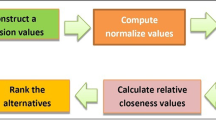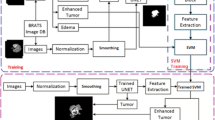Abstract
Automatic brain tissue segmentation on clinically acquired magnetic resonance image is a very challenging task due to the presence of intensity inhomogeneity, noise, and the complex anatomical structure of interest. Due to the existence of noise in clinical magnetic resonance brain images, various segmentation techniques suffer from low segmentation accuracy. Thus, to overcome the ambiguity caused by the above special effects, an enhanced fuzzy relaxation approach called fuzzy relaxation-based modified fuzzy c-means clustering algorithm is presented. In the proposed method, exposure-based sub-image fuzzy brightness adaptation algorithm is implemented for the enhancement of brain tissues, and it is followed by a modified fuzzy c-means clustering algorithm to segment the enhanced brain magnetic resonance image into white matter, gray matter and cerebrospinal fluid tissues. The proposed method is compared with other existing methods in terms of quantitative measures such as peak signal to noise ratio, discrete entropy, contrast improvement index, sensitivity, specificity, accuracy, jaccard similarity, and dice similarity coefficient. Experimental results demonstrate that the proposed method achieves a good trade-off between intensity inhomogeneity and noise. The proposed method conforms its success on brain tissue segmentation and provides extensive support to radiologists and clinical centers.










Similar content being viewed by others
References
Abdullah-Al-Wadud M, Ali Akber Dewan M, Hasanul Kabir M, Chae O (2007) A dynamic histogram equalization for image contrast enhancement. EEE Trans Consum Electron 53:593–600
Ahmed MN, Yamany SM, Mohamed N, Farag AA, Moriarty T (2002) A modified fuzzy c-means algorithm for bias field estimation and segmentation of MRI data. IEEE Trans Med Imaging 21:193–199
Al-Dmour H, Al-Ani A (2017) A clustering fusion technique for MR brain tissue segmentation. Neuro Comput 275:546–559
Bezdek JC (1981) Pattern recognition with fuzzy objective function algorithms. Plenum Press, New York
Bhandari AK (2020) A logarithmic law based histogram modification scheme for naturalness image contrast enhancement. J Amb Intell Human Comput 11:1605–1627. https://doi.org/10.1007/s12652-019-01258-6
Cai W, Chen S, Zhang D (2007) Fast and robust fuzzy c-means clustering algorithms incorporating local information for image segmentation. Pattern Recogn 40:825–838
Chen, Ramli A (2003a) Minimum mean brightness error bi-histogram equalization in contrast enhancement. IEEE Trans Consum Electron 49:1310–1319
Chen D, Ramli R (2003b) Contrast enhancement using recursive mean-separate histogram equalization for scalable brightness preservation. IEEE Trans Consum Electron 49:1301–1309
Deng Y, Ren Z, Kong Y, Bao F, Dai Q (2016) A hierarchical fused fuzzy deep neural network for data classification. IEEE Trans Fuzzy Syst 25:1006–1012
Dunn JC (1973) A fuzzy relative of the ISODATA process and its use in detecting compact well-separated clusters. J Cybernet 3(3):32–57. https://doi.org/10.1080/01969727308546046
Ghosh P, Mali K, Kumar Das S (2018) Chaotic firefly algorithm-based fuzzy C-means algorithm for segmentation of brain tissues in magnetic resonance images. J Vis Commun Image Represent 54:63–79
Gonzalez RC, Woods RE (2002) Digital image processing, 2nd ed. Prentice-Hall
Halder A, Talukdar NA (2019) Brain tissue segmentation using improved kernelized rough-fuzzy C-means with spatio-contextual information from MRI. Magn Reson Imaging 62:129–151
He Y, Hussaini MY, Ma J, Shafei B, Steidl G (2012) A new fuzzy c-means method with modified FCM regularization for segmentation of images with noisy and incomplete data. Pattern Recogn 45:3463–3471
Ji Z, Xia Y, Chen Q, Sun Q, Xia D, Feng D (2012) Fuzzy c-means clustering with weighted image patch for image segmentation. Appl Soft Comput 12:1659–1667
Kim YT (1997) Contrast enhancement using brightness preserving bi-histogram equalization. IEEE Trans Consum Electron 43:1–8
Krinidis, Chatzis V (2010) A robust fuzzy local information C-means clustering algorithm. IEEE Trans Image Process 19:1328–1337
Kuldeep Singh A, Rajiv Kapoor B (2014) Image enhancement using exposure based sub image histogram equalization. Pattern Recogn Lett 36:10–14
Kwan RK-S, Evans AC, Pike GB (1999) MRI simulation-based evaluation of image-processing and classification methods. IEEE Trans Med Imaging 18(11):1085–1097
Mahmood Q, Chodorowski A, Persson M (2015) Automated MRI brain tissue segmentation based on mean shift and fuzzy c-means using priori tissue probability maps. IRBM. 36:185–196
Masutani Y, Schiemann T, Höhne KH (1998) Vascular shape segmentation and structure extraction using a shape-based region-growing model. In: Wells WM, Colchester A, Delp S (eds) Medical image computing and computer-assisted intervention-MICCAI’98. MICCAI 1998. Lecture notes in computer science, 1496. Springer, Berlin
Narayanan A, Rajasekaran MP, Zhang Y, Govindaraj V, Thiyagarajan A (2019) Multi-channeled MR brain image segmentation: a novel double optimization approach combined with clustering technique for tumor identification and tissue segmentation. Biocybernet Biomed Eng 39(2):350–381
Ortiz J, Gorriz J, Ramirez GJ, Salas-Gonzalez D (2014) Improving MR brain image segmentation using self-organizing maps and entropy gradient clustering. Inf Sci 262:117–136
Portela NM, Cavalcanti GD, Ren TI (2014) Semi-supervised clustering for MR brain image segmentation. Expert Syst Appl 41:1492–1497
Ren T, Wanga H, Feng H, Chensheng X, Liu G, Ding P (2019) Study on the improved fuzzy clustering algorithm and its application in brain image segmentation. Appl Soft Comput J 81:1–9
Sahnouna M, Kallela F, Dammak M, Mhiri OK, Mahfoudh KB, Hamida AB (2019) A modified DWT-SVD algorithm for T1-w brain MR images contrast enhancement. IRBM 40:235–243
Saravanan S, Karthigaivel R, Magudeeswaran V (2020) A brain tumor image segmentation technique in image processing using ICA-LDA algorithm with ARHE model. J Amb Intell Human Comput. https://doi.org/10.1007/s12652-020-01875-6
Sheet D, Garud H, Suveer A, Mahadevappa M, Chatterjee J (2010) Brightness preserving dynamic fuzzy histogram equalization. IEEE Trans Consum Electron 56:2475–2480
Subramani B, Veluchamy M (2018) MRI brain image enhancement using brightness preserving adaptive fuzzy histogram equalization. Int J Imaging Syst Technol 28:217–222
Subramani B, Veluchamy M (2019) Fuzzy contextual inference system for medical image enhancement. Measurement 148:106967
Subramani B, Veluchamy M (2020) Fuzzy gray level difference histogram equalization for medical image enhancement. J Med Syst 44:103. https://doi.org/10.1007/s10916-020-01568-9
Szilagyi L, Szilágyi SM, Benyó Z (2007) A modified fuzzy C-means algorithm for MR brain image segmentation. In: Kamel M, Campilho A (eds) Image analysis and recognition. ICIAR 2007. Lecture notes in computer science, Springer, Berlin
Veluchamy M, Mayathevar K, Subramani B (2019) Brightness preserving optimized weighted bi-histogram equalization algorithm and its application to MR brain image segmentation. Int J Imaging Syst Technol 1–14
Wang Y, Chen Q, Zhang B (1999) Image enhancement based on equal area dualistic sub-image histogram equalization method. IEEE Trans Consum Electron 45:68–75
Wang J, Kong J, Lu Y, Qi M, Zhang B (2008) A modified FCM algorithm for MRI brain image segmentation using both local and non-local spatial constraints computerized. Med Imaging Graph 32:685–698
Zaixin Z, Lizhi C, Guangquan C (2014) Neighbourhood weighted fuzzy c means clustering algorithm for image segmentation. IET Image Proc 8:150–161
Zhao F, Jiao L, Liu H (2011) Fuzzy c-means clustering with non-local spatial information for noisy image segmentation. Front Comput Sci China 5:45–56
Author information
Authors and Affiliations
Corresponding author
Ethics declarations
Conflict of interest
No conflict of interest.
Availability of data and material
Nil.
Code availability
MATLAB Software Code.
Additional information
Publisher's Note
Springer Nature remains neutral with regard to jurisdictional claims in published maps and institutional affiliations.
Rights and permissions
About this article
Cite this article
Veluchamy, M., Subramani, B. Brain tissue segmentation for medical decision support systems. J Ambient Intell Human Comput 12, 1851–1868 (2021). https://doi.org/10.1007/s12652-020-02257-8
Received:
Accepted:
Published:
Issue Date:
DOI: https://doi.org/10.1007/s12652-020-02257-8




